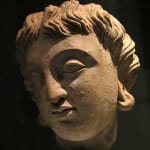Bactrian Royal Head, 250 BCE - 125 BCE
Terracotta
height 27.9 cm
height 11 in
height 11 in
LO.1087
Further images
This beautiful terracotta head was made in one of Central Asia’s most dynamic and fascinating periods, when the mighty forces of east and west were coming into full contact in...
This beautiful terracotta head was made in one of Central Asia’s most dynamic and fascinating periods, when the mighty forces of east and west were coming into full contact in the wake of Alexander’s Empire. It bears characteristics of both endemic (Afghanistan and Bactria) and western (Greek and Mediterranean) styles. The piece is truncated at the neck, and would onece have been part of a large sculpture or a frieze. The face is naturalistic, with full cheeks, a high forehead, sensitive lips and a long nose. The brows are tendered geometrically, as are the eyes, which have more in common with the eastern aesthetic in their schematic reductivism. The ears are pierced with thick rings, beneath a coiffure comprised of carefully-arranged waves and ringlets. The head is tipped very slightly to the right, lending a reflective sensitivity.
The Greco-Bactrian Kingdom covered today's northern Afghanistan and parts of Central Asia, the easternmost area of the Hellenistic world, from 250 to 125 BCE. The expansion of the Greco- Bactrians into northern India from 180 BCE established the Indo-Greek Kingdom, which was to last until around 10 AD. This kingdom was highly urbanized and was widely considered to be one of the richest of the Orient, expanding to the east and the west. The numerous small city states and powers began to compete as western influence waned in the area, leading to marked cultural and stylistic diversity. The artworks of Central Asia reflect this, and there are perhaps no finer examples than Greco- Bactrian portraiture like the current example. The identity of the person portrayed is uncertain, but is likely to represent a king or ancestor, that would have been displayed as a social point for the society in question.
This is a world-class piece of ancient art, and one of the finest such specimens we have seen.
The Greco-Bactrian Kingdom covered today's northern Afghanistan and parts of Central Asia, the easternmost area of the Hellenistic world, from 250 to 125 BCE. The expansion of the Greco- Bactrians into northern India from 180 BCE established the Indo-Greek Kingdom, which was to last until around 10 AD. This kingdom was highly urbanized and was widely considered to be one of the richest of the Orient, expanding to the east and the west. The numerous small city states and powers began to compete as western influence waned in the area, leading to marked cultural and stylistic diversity. The artworks of Central Asia reflect this, and there are perhaps no finer examples than Greco- Bactrian portraiture like the current example. The identity of the person portrayed is uncertain, but is likely to represent a king or ancestor, that would have been displayed as a social point for the society in question.
This is a world-class piece of ancient art, and one of the finest such specimens we have seen.







